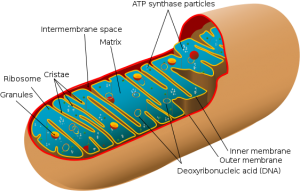When I first studied mitochondria, back when I was a high school student, I didn’t appreciate their importance or their origin. I got a lot smarter recently, especially after reading “The Energetics of Genome Complexity,” by Nick Lane and William Martin, in the October 21, 2010 edition of Nature (available online only to subscribers). I now realize that Mitochondria are organelles that generate energy in the form of ATP, and that without mitochondria, humans wouldn’t exist.
Lane and Martin begin their article by asking: “Bacteria made a start up virtually every avenue of eukaryotic complexity, but then stopped short. Why?” As I indicated, in this article, I learned many things about mitochondria. I have inserted excerpts from the Lane/Martin article in several locations.
Mitochondria formerly existed as their own independent life form (they were proto-bacteria), but they now reside within other cells. This combining of mitochondria happened only once about four billion years ago and all eukaryotes descended from that symbiotic occurrence. All Eukaryotes had mitochondria (or once did but lost them).
All eukaryotes share a common ancestor, which arose from prokaryotes just once in 4 billion years. Genomic chimaerism points to the origin of eukaryotes in an endosymbiosis between eukaryotes. All eukaryotes either possessed mitochondria, or once did and later lost them, placing the origin of mitochondria and the eukaryotic cell as possibly the same event.
The host mitochondria were also prokaryotes. This was determined by Russian botanist Konstantin Mereschkowski in 1905 and, as you might expect, he was not believed.
Despite being swallowed by another prokaryote, mitochondria maintain their own DNA (there are 16,000 base pairs that code for 37 proteins). In humans, mitochondrial DNA is donated by the egg only, not the sperm.
The question, we posit, presides alternately in mitochondrial genes. By enabling oxidative phosphorylation across a wide area of internal membranes, mitochondrial genes enabled a roughly 200,000 fold rise in genome size compared with bacteria. Whereas the energetic cost of possessing genes is trivial, the cost of expressing them as protein is not and consumes most of the cell’s energy budget. Mitochondria increase the number of proteins that cell can evolve, inherit and expressed by 4 to 6 orders of magnitude, this requires mitochondrial DNA
The presence of mitochondria allows eukaryotes to have a 200,000 fold increase in genome size.
The possession of mitochondria enabled eukaryotes . . . to evolve, explore and express 200,000 fold more genes with no energetic penalty. This is because mitochondria obliterated the heavy selection pressure to remove superfluous DNA (and potential proteins), which is among the most pervasive selective forces in prokaryote genome evolution. Eukaryotes harbor approximately 12 genes per megabyte, compared with about 1000 and bacteria.
It takes considerably more energy to manufacture higher numbers of complex folded proteins found in eukaryotes. (check out this animation of cellular proteins in action).

The cost of DNA replication itself accounts for just 2% of the energy budget of microbial cells during growth. In contrast, protein synthesis accounts for remarkable 75% of the cell’s total energy budget . . .
The cornerstone of eukaryotic complexity is a vastly expanded repertoire of novel protein folds, voting interactions and regulatory cascades. The eukaryote common ancestor increases genetic repertoire by some 3000 novel gene families. The invention of new protein folds in the eukaryotes was the most intense phase of gene invention since the origin of life. Eukaryotes invented five times as many protein folds as eubacteria, and 10 times as many as archea.
Mitochondria, which divide within our own cells, allowed 4-6 orders of magnitude increase in number and types of proteins in eukaryotic cells.
We wouldn’t be here reading this if mitochondria hadn’t joined up with a host cell billions of years ago. In fact, the author argue that such a bioenergetic arrangement would be necessary in order to see any complex life forms.
The transition to complex life on earth was a unique event that hinged on a bioenergetic jump afforded by spatially combinatorial relations between two cells and two genomes (endosymbiosis , rather than natural selection acting on mutations accumulated gradually among physically isolated prokaryotic individuals. Given the energetic nature of these arguments, the same is likely to be true of any complex life elsewhere.


Here's a vivid video of mitochondria function. http://multimedia.mcb.harvard.edu/